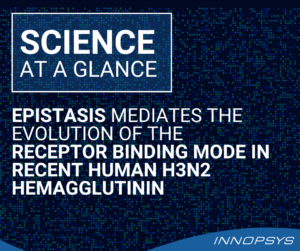SCIENCE AT A GLANCE
Epistasis mediates the evolution of the receptor binding mode in recent human H3N2 hemagglutinin
Since the 1968 “Hong Kong flu” pandemic, H3N2 subtype of influenza A virus has been circulating in human for over half a century. As the major antigen of influenza virus, hemagglutinin (HA) glycoprotein is the fastest evolving protein in human H3N2 virus. HA facilitates virus entry by engaging the sialylated glycan receptor and mediating virus-host membrane fusion. G186D and D190N mutations in the hemagglutinin receptor-binding site have coevolved in two recent human H3N2 clades. These mutations are shown to significantly influence the receptor binding site of HA, facilitating enhanced binding to α2,6-linked sialylated glycans which are characteristic of human-type receptors. InnoScan 1100AL microarray scanner is employed in the glycan array analysis to demonstrate the epistasis between G186D and D190N mutations by quantifying the binding interactions between HA variants and glycans.
Original publication : https://doi.org/10.1038/s41467-024-49487-4
#InfluenzaA #Glycanarray #Microarrayscanner


